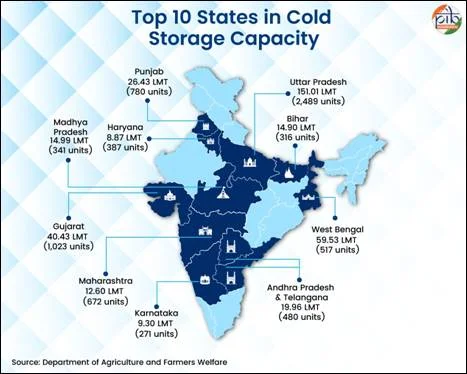Facts for UPSC Mains
Food Grain Storage in India
- 03 Oct 2025
- 8 min read
Why in News?
India has achieved a record foodgrain production of 353.96 million tonnes for 2024-25, as per the Third Advance Estimates. To preserve this surplus, modern storage infrastructure is crucial to minimize post-harvest losses, ensure safe storage, and stabilize prices.
What is a Foodgrain Storage System in India?
- About: The foodgrain storage system in India is a network of facilities and mechanisms designed to preserve harvested foodgrains, prevent post-harvest losses, and ensure year-round availability for consumers and the Public Distribution System (PDS).
- It integrates centralized, decentralized, and cold storage infrastructures, linking farmers, state agencies, and markets.
- Around 60-70% of the foodgrain produced is stored at the household level by small farmers, utilizing traditional indigenous storage methods like Morai and Mud Kothi.
Storage System in India
- Government Storage Agencies:
- Food Corporation of India (FCI): Established in 1965 through an Act of Parliament, FCI is the primary agency responsible for the storage of food grains in India.
- It operates food storage depots nationwide, including silos, godowns, and Cover and Plinth (CAP) structures.
- Currently, FCI and State agencies manage 917.83 LMT capacity.
- Central Warehousing Corporation (CWC): Established under the Warehousing Corporations Act, 1962, the CWC manages the storage of agricultural produce and other notified commodities.
- State Warehousing Corporations: These are set up under respective state warehousing Acts to regulate the storage of certain goods within each state.
- Food Corporation of India (FCI): Established in 1965 through an Act of Parliament, FCI is the primary agency responsible for the storage of food grains in India.
- Private Agencies:
- FCI also rents storage capacity from private owners to meet storage needs.
- Other Stakeholders:
- Key contributors to grain management include the Warehouse Development and Regulatory Authority (WDRA), Railways, and the Civil Supply Departments of states.
Importance of Foodgrain Storage
- Reduces Post-Harvest Losses: Proper storage preserves quantity and quality.
- Ensures Food Security: Maintains buffer stocks for PDS and national emergencies.
- Stabilizes Prices: Strategic storage prevents extreme price fluctuations.
- Supports Farmers’ Income: Enables farmers to sell at optimal times, avoiding distress sales.
- Strengthens Food Processing & Supply Chain: Provides raw material availability for industries and export potential.
What Initiatives has India Taken to Enhance Food Grain Storage Infrastructure?
- Agriculture Infrastructure Fund (AIF) was launched in 2020 to strengthen agricultural infrastructure across India.
- It is a medium-long term debt financing facility through interest subvention and credit guarantee support on loans for investment in viable projects for post-harvest management infrastructure and viable farming assets.
- Agricultural Marketing Infrastructure (AMI) scheme is a key component of the Integrated Scheme for Agricultural Marketing (ISAM).
- The objective of this scheme is to strengthen agricultural marketing infrastructure across rural India by providing financial assistance for the construction and renovation of godowns and warehouses.
- Pradhan Mantri Kisan SAMPADA Yojana (PMKSY) is a comprehensive scheme designed to build modern infrastructure for the food processing sector, creating a smooth and efficient supply chain from the farm gate to retail.
- It helps farmers get better prices for their produce, reduces wastage, and supports the goal of doubling farmers’ income especially in rural areas, increases food processing levels, and boosts exports of processed food products.
- Schemes for Augmentation of Storage Capacity
- Construction of Steel Silos for Modernized Storage.
- Private Entrepreneurs Guarantee (PEG) scheme
- Central Sector Scheme “Storage & Godowns” (Focus on NE)
What are the Key Challenges in Maintaining Grain Storage & Suggest Measures to Address Them?
|
Challenges |
Measures to Enhance Grain Storage |
|
High Post-Harvest Losses: India loses about 22% of its foodgrain output annually (~74 million tonnes in 2022-23). |
Expand Scientific Storage: Scale up silos and modern warehouses (e.g., 50,000 MT silo in Bihar inaugurated in 2025). |
|
Storage-Specific Losses: Around 6.58% of foodgrains are lost due to poor storage (pests, rodents, moisture damage). |
Reduce Losses via Better Post-Harvest Practices: Curb cereal losses during drying, cleaning, and marketing by maintaining safe moisture levels. |
|
Economic Burden: Annual storage losses are estimated at worth ₹7,000 crore, with insects responsible for ~₹1,300 crore in losses. |
Encourage PPPs (Public-Private Partnerships): Strengthen the PEG Scheme by providing long-term hiring guarantees to attract private investors. |
|
Dependence on CAP Storage: Nearly 90% of wheat in Punjab is stored under Cover and Plinth (CAP), which is highly vulnerable. |
Empower PACS (Primary Agricultural Credit Societies): Fast-track the computerisation of ~63,000 PACS to benefit ~13 crore farmers and improve transparency. Focus on North-East, hilly, and tribal regions to address storage gaps through targeted schemes. |
Conclusion
India’s journey from food deficit to food surplus has made scientific storage and distribution as critical as production itself. Strengthening storage through modern silos, PACS-based godowns, and cold chain infrastructure will not only reduce post-harvest losses but also ensure price stability, food security, and farmer welfare.
|
Drishti Mains Question: The real challenge to India’s food security is poor grain management rather than a shortage of grain production. Comment. (250 words) |
Frequently Asked Questions (FAQs)
1. What is foodgrain storage infrastructure in India?
It includes FCI godowns, PACS village storage, steel silos, and cold storage facilities. Its purpose is to preserve grains, reduce post-harvest losses, and ensure food security.
2. What are the Key types of storage systems?
India has centralized storage, decentralized storage, and cold storage for perishable commodities like fruits, vegetables, and dairy.
3. How do PACS contribute to storage?
PACS provide village-level storage near farms, helping farmers avoid distress sales, access better prices, and reduce transport costs for the PDS.







